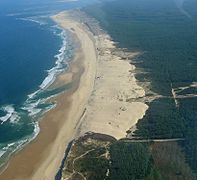Aquitaine
Aquitaine (Occitan: Aquitània; Basque: Akitania; Spanish: Aquitania) is a part of southwestern France. It was once an administrative region but is now part of the administrative region of Nouvelle-Aquitaine. With over 41,000 square kilometers, it is one of the largest regions of mainland France (the largest of all French regions is French Guiana, in South America).
Aquitaine Aquitània (Occitan) | |
|---|---|
 | |
| Coordinates: 44°35′N 0°00′E / 44.583°N 0.000°E | |
| Country | |
| Dissolved | 2016-01-01 |
| Prefecture | Bordeaux |
| Departments | |
| Government | |
| • President | Alain Rousset (PS) |
| Area | |
| • Total | 41,308 km2 (15,949 sq mi) |
| Population (2012)INSEE | |
| • Total | 3,285,970 |
| • Density | 80/km2 (210/sq mi) |
| Time zone | UTC+1 (CET) |
| • Summer (DST) | UTC+2 (CEST) |
| ISO 3166 code | FR-B |
| GDP (2012)[1] | Ranked 6th |
| Total | €90.8 billion (US$116.8 bn) |
| Per capita | €27,583 (US$35,478) |
| NUTS Region | FR61 |
| Website | Region of Aquitaine |
Its capital was Bordeaux, the largest city. The French name of the people living in the region is Aquitain.
The five departments in the region were Dordogne, Gironde, Landes, Lot-et-Garonne, and Pyrénées-Atlantiques.
Geography
The Aquitaine region was the third largest region of Metropolitan France, after Midi-Pyrénées and Rhône-Alpes. Its area was 41,284 km2 (15,940 sq mi).[2] It bordered with three French regions: Poitou-Charentes to the north, Limousin to the northeast and Midi-Pyrénées to the east. To the south is Spain (Aragon and Navarre) and to the west the Atlantic Ocean. The coast along the Atlantic Ocean, part of the Bay of Biscay, is called the Côte d'Argent (Silver Coast).
The Greenwich Meridian passes through Aquitaine.
Most of Aquitaine is in the Aquitanian basin,[N 1] a relatively flat and geologically young landscape. High mountains are found only in the south of Aquitaine, in the Pyrenees mountain range. The Pic Palas (42°50′58″N 0°18′48″E / 42.84944°N 0.31333°E), at 2,974 m (9,757 ft), is the highest point of Aquitaine; it is on the border with Spain.[3]
The main rivers of the region are the Garonne, that flows through the Gironde and Lot-et-Garonne departments;[4] the Dordogne, that flows through the Dordogne and Gironde departments;[5] the Lot, that flows through the Lot-et-Garonne department;[6] the Dropt, that flows through the Dordogne, Gironde and Lot-et-Garonne departments;[7] and the Adour, that flows through the Landes department.[8]
The climate is mild - except in the high mountains - all year round. On the Atlantic coast, the annual average temperature is above 15 °C, in Bordeaux is about 14 °C and on the border of Limousin is still 11 °C. Rainfall is relatively high and is higher in the south of the region.
History
In the Middle Ages Aquitaine was at times a kingdom and a duchy. Various wars made it larger and smaller. Aquitane came into the control of England when Eleanor of Aquitaine married Henry II of England in 1152. It remained in English control until 1453 at the end of the Hundred Years' War.
Departments
The Aquitaine region is formed by five departments:
| Département | Préfecture | ISO 3166-2 | Population (2012)[9] | Area (km²) | Density (Inh./km²) |
|---|---|---|---|---|---|
| Dordogne | Périgueux | FR-24 | 416,384 | 9,060 | 46.0 |
| Gironde | Bordeaux | FR-33 | 1,483,712 | 9,975 | 148.7 |
| Landes | Mont-de-Marsan | FR-40 | 392,884 | 9,243 | 42.5 |
| Lot-et-Garonne | Agen | FR-47 | 332,119 | 5,361 | 62.0 |
| Pyrénées-Atlantiques | Pau | FR-64 | 660,871 | 7,645 | 86.4 |
Demographics
The Aquitaine region had a population, in 2012, of 3,285,970,[10] for a population density of 79.6 inhabitants/km2.

The 10 most important cities in the department are:
| City | Population (2012)[9] | Départment |
|---|---|---|
| Bordeaux | 241,287 | Gironde |
| Pau | 78,506 | Pyrénées-Atlantiques |
| Mérignac | 66,660 | Gironde |
| Pessac | 59,223 | Gironde |
| Bayonne | 45,855 | Pyrénées-Atlantiques |
| Talence | 41,358 | Gironde |
| Anglet | 39,223 | Pyrénées-Atlantiques |
| Agen | 33,730 | Lot-et-Garonne |
| Mont-de-Marsan | 31,018 | Landes |
| Périgueux | 29,906 | Dordogne |
Gallery
Notes
References
Other websites

- Regional Council of Aquitain official website Archived 2016-10-12 at the Wayback Machine (in French)
- Visit Aquitaine Archived 2015-03-16 at the Wayback Machine
- Regional information and tourist attractions
- Aquitaine: the cradle of humanity Archived 2015-04-05 at the Wayback Machine





